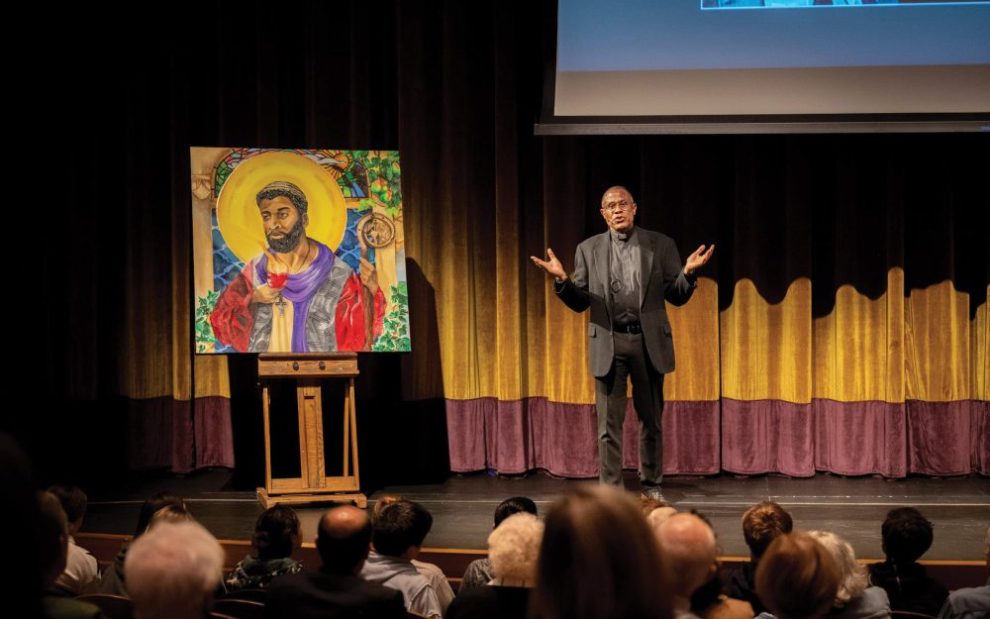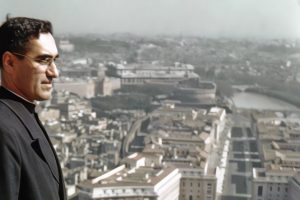Last November I delivered the annual Mother Mary Lange Lecture in Black Catholic Studies at Villanova University. (November is when we recall the contributions that Catholics of African descent have made to our church.) Before my presentation, the university unveiled a painting of St. Augustine of Hippo, the patron saint of the university’s sponsors, the Augustinian Order. The university commissioned a young Black artist, Vernon Adams, to create a work of art that depicts the saint as the North African man that he was. It is stunningly beautiful.
During the unveiling ceremony, speakers remarked that while there are many images of Augustine on the campus, this is the first that shows him as a non-European. This painting not only corrects the historically inaccurate portrayals of the saint, but it also witnesses to the true universality of the Catholic faith. Our heritage includes Africans who are both scholars of faith and models of holiness.
Sadly this event shows how so much of our Catholic history and faith have been literally whitewashed. Black people have lived lives worthy of emulation. They are among the exemplars of what it means to follow Jesus. Yet most Catholics are unaware that African-descended people have been models of holiness.
Such models of holiness include founders of religious orders such as Henriette Delille and Mary Elizabeth Lange. Both of these women were pioneers of women’s religious life in the United States. They established the first religious orders—the Sisters of the Holy Family and the Oblates of Providence—that accepted Black women as vowed religious. Among Black models of holiness is also Augustus Tolton, the first publicly known Black man to be ordained and serve as a priest in this country. These models also include Thea Bowman, a Black woman who entered the convent, ministered as a professor and revivalist, and delivered a stirring address to the U.S. bishops in 1989.
All of these have been declared a “servant of God” or “venerable,” and are thus on the road to canonization. What makes their faith journeys remarkable is that they lived lives of holiness in the face of the racist ostracism, opposition, and vilification of their fellow Catholics.
For example, Delille and her sisters were refused permission to wear religious habits outside the confines of their convent in New Orleans, as were Lange’s sisters in Baltimore. That religious garment was seen as too sacred to be sullied and defiled by a Black body.
Tolton lived a lonely life, despised and rejected by many of his fellow white priests. He was forbidden from celebrating Masses in some places because of the color of his skin. Or, said more honestly, because white Catholics would be scandalized by the sight of a Black man representing Jesus at the altar.
Perhaps this is why these figures are so poorly known by the nation’s Catholics. Because an honest look at their lives reveals terrible truths that many, especially white people, would rather not face. And perhaps because they would force us to realize that many of the dynamics and obstacles they had to face have not yet been overcome. Honestly acknowledging that Black people can be holy exposes the lie that white racism needs in order to keep unjust racial privilege in place, namely, that Black people are inherently inferior to or less worthy than white people.
Holding up Black models of holiness and declaring that Black lives are worthy of emulation and veneration is perhaps one of the best weapons the Catholic Church has in the struggle for racial justice.
By acknowledging St. Augustine’s African origins and likely appearance, Villanova did more than correct the historical record. The painting represents a small step toward recognizing what the Second Vatican Council called “the universal call to holiness.” By commissioning and displaying this work of art, a part of the church declares that God’s grace is found even in those whom human beings despise and disdain. This painting becomes a proclamation of the gospel, the good news that Christ identifies himself with “the least among us.” Black lives not only matter; they are holy. They are worthy of imitation and acclaim. And they deserve respect and protection.
It’s time for the rest of the church to catch up to what God is doing—and has already done.
This article also appears in the March 2023 issue of U.S. Catholic (Vol. 88, No. 3, pages 40-41). Click here to subscribe to the magazine.
Image: Father Bryan Massingale delivers the annual Mother Mary Lange Lecture in Black Catholic Studies at Villanova University in November 2022, alongside artist Vernon Adams’ painting An Unlikely Aquilegia: North African Saint of Hippo. Courtesy of the Office for Mission and Ministry, Villanova University.













Add comment